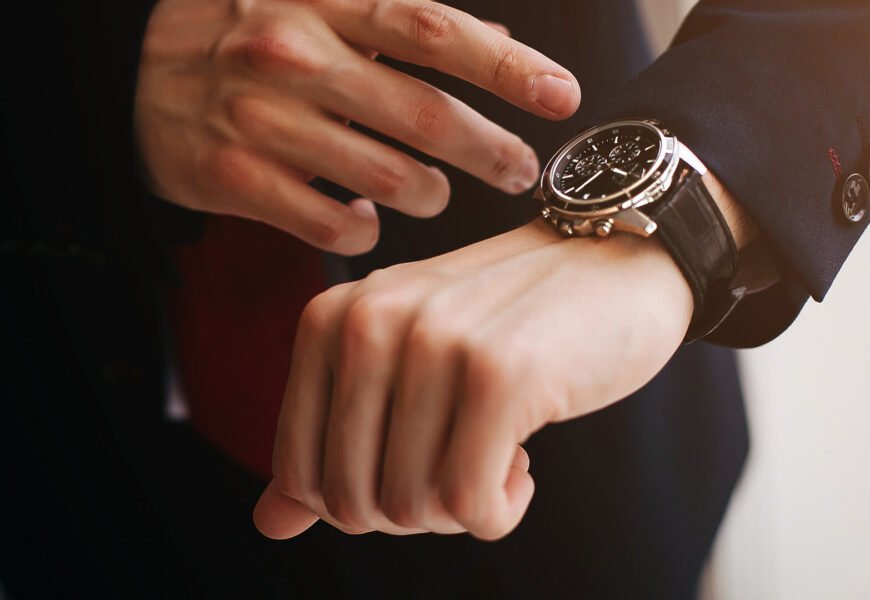Wearing a watch is often seen as a simple habit or a matter of style. Most of us wear it on the left hand without thinking twice, but when someone chooses to wear a watch on the right hand, it sparks curiosity. Could it be just comfort? Or does it hold a deeper meaning? Surprisingly, cultures, psychology, and even subtle personality traits reveal that wearing a watch on the right hand may signify far more than we imagine.
Let’s explore 20 powerful and insightful meanings behind this unique choice.
1. A Sign of Independence and Breaking Tradition
Wearing a watch on the right hand is often seen as a subtle act of independence. Traditionally, watches are designed for the left wrist, since most people are right-handed and find it easier to adjust the watch with their dominant hand. But when someone breaks this norm and chooses the right wrist, it suggests a mindset that doesn’t blindly follow convention.
This small choice reflects an individual’s willingness to question traditions and rewrite rules for their own comfort. Such people are often independent thinkers who don’t mind standing out from the crowd. They prioritize practicality over societal expectations and prefer to live life on their own terms. Wearing the watch on the right wrist becomes a quiet but powerful declaration of autonomy.
In many cases, this independence translates to other areas of life too. People who wear their watch on the right hand often have a bold personality, prefer unique styles, and value self-expression. They aren’t afraid of judgment because they know their choices are based on what works for them—not what pleases others.
2. Symbol of Left-Handedness and Creativity
One of the most common reasons someone wears a watch on the right wrist is simply that they are left-handed. Since their dominant hand is the left, it makes more sense to keep that wrist free and use the right hand to wear a timepiece. But beyond practicality, left-handedness itself is often associated with creativity, artistic thinking, and unique perspectives.
Psychologists have found that left-handed people tend to engage the right side of the brain more actively, which is linked to imagination, intuition, and innovation. When such individuals wear a watch on their right wrist, it not only reflects functionality but also highlights their distinct approach to life.
Interestingly, society has long viewed left-handed people as unconventional or different. In many cultures, being left-handed was once stigmatized, but now it’s increasingly seen as a mark of individuality. Thus, the watch on the right hand becomes a quiet symbol of creative power and originality—an accessory that reveals more than just the time.
3. A Statement of Confidence and Bold Personality
Wearing a watch on the right wrist is not something most people do. And because of this rarity, it naturally draws attention. For some, this choice isn’t accidental but intentional—a subtle way of making a statement. It suggests confidence, boldness, and a willingness to be noticed.
People who wear their watch on the right hand often exude an aura of self-assurance. They’re comfortable being different and don’t shy away from standing out. In social settings, this small difference can spark curiosity, conversations, or even admiration, as others notice their unusual choice.
A confident personality often reflects in other areas too—career, relationships, and social interactions. Such individuals are usually strong-willed, assertive, and unafraid to take the lead. The right-hand watch becomes more than an accessory; it’s a reflection of a personality that embraces individuality and proudly wears it on the wrist for the world to see.
4. Cultural or Spiritual Symbolism
In some cultures, the wrist on which you wear your watch or jewelry holds symbolic meaning. For instance, the right side of the body is often associated with masculine energy, strength, and action, while the left side symbolizes femininity, intuition, and receptivity. By wearing a watch on the right wrist, some people may be unconsciously expressing their connection with energy linked to action, drive, and assertiveness.
In spiritual traditions, the right hand is often considered the “giving hand.” It represents how we extend ourselves to the world, share energy, and interact with others. A watch on the right wrist, therefore, could signify a person’s outward focus—someone who values time not just for themselves, but for how they dedicate it to others.
For some, this act may even carry ritualistic or personal significance. Whether rooted in cultural traditions or spiritual interpretations, the choice to wear a watch on the right wrist reveals deeper layers of meaning that go beyond mere style.
5. Practicality and Comfort
Not all reasons are psychological or symbolic—sometimes, it’s just about practicality. For people who use their left hand frequently for writing, sports, or work, wearing a watch on the left wrist can feel restrictive or uncomfortable. Moving the watch to the right wrist gives them more freedom of movement and prevents scratches or damage.
This choice shows a personality that values comfort, efficiency, and adaptability. Instead of blindly following societal norms, they make decisions that improve their daily lives. For some, this could be a reflection of a problem-solving mindset—someone who thinks logically and prioritizes convenience over conformity.
In the end, practicality can be just as powerful a statement as symbolism. It shows that the person is not afraid to make small but meaningful adjustments that suit their lifestyle, even if it means being different. Wearing a watch on the right hand thus becomes an emblem of personal comfort, efficiency, and confidence in practical decision-making.
6. A Reflection of Ambidextrous Traits
Ambidextrous people—those who use both hands almost equally—sometimes choose the right wrist for a watch simply because it feels natural. But beyond comfort, ambidexterity itself is rare and often linked to adaptability, balance, and unique mental wiring. Such individuals are skilled at switching tasks, thinking flexibly, and seeing problems from multiple angles.
Wearing a watch on the right hand, then, may symbolize this balanced, dual approach to life. It becomes a reminder of their ability to navigate both logic and creativity, structure and freedom, tradition and modernity. These people often thrive in environments that require multitasking, leadership, or innovation.
In essence, the watch on the right hand for an ambidextrous person is not just about habit—it reflects their adaptability, their gift of balance, and their ability to flow where life takes them without feeling restricted.
7. Psychological Association with Dominance and Authority
Psychology often connects the right side of the body with dominance and assertiveness. The right wrist, in particular, is linked to outward action—the hand that greets, signs contracts, and takes initiative. Wearing a watch on this wrist, therefore, can symbolically underline someone’s leadership qualities and their drive to take charge.
People who make this choice might be more authoritative in their behavior, more assertive in their decision-making, and more active in their pursuit of goals. The act of placing a watch—a timekeeper—on their dominant side becomes a statement of control, power, and responsibility.
In leadership settings, such individuals often appear decisive and grounded. They see time as a resource that must be actively managed, not passively observed. Wearing a watch on the right wrist becomes a subtle reflection of their dominance over their schedule and their life.
8. Rebellion Against Social Norms
Traditionally, watch companies design timepieces for the left wrist. This expectation has been carried into society as an unspoken rule. Choosing to wear a watch on the right hand, then, is often an act of rebellion—a small yet meaningful refusal to conform.
This rebellious streak doesn’t always mean aggression or defiance; it could simply signal a person who enjoys breaking away from patterns and standing apart. They may resist societal expectations in other aspects too, choosing careers, lifestyles, or partners that others might not approve of.
A right-hand watch, in this sense, becomes a symbol of freedom, resistance, and individuality. It communicates: “I don’t follow the rules because they’re there—I follow what works for me.”
9. Practical Needs of Left-Handed Professions
Some professions naturally require more use of the left hand—such as artists, musicians, surgeons, or athletes. For them, wearing a watch on the right wrist is not just symbolic but practical. It prevents obstruction, allows free movement, and keeps their dominant hand unburdened.
This choice reveals the deep connection between profession, identity, and lifestyle. For example, a guitarist may keep their left hand free for chords, while a surgeon may avoid wearing anything on the hand that performs delicate procedures. The watch on the right wrist becomes part of their professional rhythm—a silent partner in their craft.
Thus, the meaning here is rooted in purpose: it shows how individuals shape even their accessories around the work that defines their lives.
10. Expression of Personal Style and Fashion Identity
Fashion is one of the most personal forms of self-expression. For many, wearing a watch on the right hand isn’t about psychology or tradition—it’s simply about aesthetics. They may feel the right wrist balances better with their rings, bracelets, or tattoos, or they simply like how it looks in photos.
This choice reveals a personality that values visual balance and individuality. Fashion-forward people often experiment with such details, using small changes to create a bigger statement. The right-hand watch, then, becomes not just an accessory but part of their fashion identity—a reflection of how they see themselves and how they wish to be seen by others.
It may not be practical or traditional, but it is undeniably stylish—and for some, that is the most important meaning of all.
11. Symbol of Protectiveness Over the Left Hand
Some people view their left hand as more delicate or reserved, especially if it carries sentimental jewelry like a wedding ring. In such cases, wearing a watch on the right wrist becomes an act of protecting or preserving the left hand’s symbolic importance.
This choice may stem from emotional reasons—valuing the left hand as a space for intimacy, memory, or sacred commitments—while the right hand is seen as the “functional” one. The watch, therefore, moves to the right to maintain balance and respect for what the left side represents.
This subtle decision highlights how accessories can carry emotional weight, showing that even a watch placement can be tied to personal values and emotional significance.
12. Representation of Outward Focus
The right hand is the one most often extended to others—whether in handshakes, waves, or gestures. Wearing a watch on this wrist can symbolize a person’s outward focus: their time is not just for themselves but also for the world they engage with.
This may reflect generosity, hospitality, or a career centered on serving others. Such individuals often prioritize relationships, community, or professional service. The watch on the right wrist becomes a symbolic reminder that their time belongs not only to them but also to those they interact with daily.
It’s a meaningful gesture that turns a personal accessory into a sign of outward dedication and responsibility.
13. Connection with Masculine or Feminine Energy
As mentioned earlier, the body is often divided symbolically into left (feminine, intuitive) and right (masculine, assertive). Wearing a watch on the right hand can signal alignment with traditionally masculine traits—such as strength, determination, and action—even if the wearer is female.
This doesn’t necessarily mean rejecting femininity; rather, it may show a balance or preference for energy that emphasizes doing, achieving, and leading. For women, it may highlight empowerment and breaking gender stereotypes. For men, it may reinforce traits like confidence and structure.
Thus, the watch on the right wrist becomes a quiet reflection of the energies they choose to express more strongly in their lives.
14. Symbol of Time Consciousness in Action
Some people see time as something to be actively managed rather than passively observed. By placing their watch on the right wrist—the hand of action—they align their time with their deeds. It’s almost symbolic: the hand that signs papers, shakes hands, and builds things also carries the watch, reminding them to act with urgency and purpose.
This alignment reflects a personality that is highly time-conscious, disciplined, and focused on results. They don’t let hours slip away unnoticed—they live by deadlines, goals, and achievements. For them, the watch on the right wrist is not just about style but about aligning time with productivity.
15. A Subtle Sign of Introversion or Privacy
Sometimes, the reason is the opposite of attention-seeking. A person may wear their watch on the right wrist because it feels less noticeable there, or because fewer people expect it. This small choice could reflect introversion, privacy, or a desire to keep personal habits shielded from the crowd.
Introverts often find comfort in small acts that allow them to feel unique without necessarily standing out too much. For them, the watch becomes a personal companion rather than a public statement. Its position on the right wrist is subtle but meaningful—a reflection of their quiet, inward-focused personality.
16. Influence of Role Models or Family Traditions
Sometimes, habits are inherited. A person may wear a watch on the right wrist simply because a parent, sibling, or admired role model did so. Over time, this becomes not just a habit but a symbolic link to someone they respect or love.
This meaning shows how even small lifestyle choices can carry generational or emotional significance. The watch placement becomes part of a family identity or a personal tribute—quietly reminding the wearer of their connection to someone important.
17. Convenience for Gadget Users
In today’s digital age, smartwatches are often worn differently than traditional watches. Some users prefer the right wrist because it allows easier use of buttons, touchscreens, or features depending on which hand feels more natural.
This practical adaptation highlights how technology is reshaping even symbolic habits. The right-hand watch, in this context, reflects a modern personality—someone who adapts quickly to new tools, embraces technology, and prioritizes efficiency.
18. A Marker of Individual Quirkiness
Some people simply enjoy being different. They wear a watch on the right wrist as a playful quirk, not because of symbolism, comfort, or practicality. It becomes their signature trait—a small but consistent detail that others associate with them.
This quirkiness often reveals a fun, lighthearted personality. They don’t take trends too seriously and enjoy adding a touch of individuality to everyday habits. For them, the right-hand watch is a conversation starter, an inside joke, or simply a reflection of their cheerful uniqueness.
19. Symbol of Balance Between Past and Future
The left hand is often associated with memory, intuition, and the past, while the right hand represents the future and action. By wearing a watch on the right hand, some people unconsciously place their focus on the future—on progress, ambition, and forward motion.
It becomes a symbolic way of saying: “My time is not behind me—it is ahead of me.” This perspective highlights optimism, growth, and a goal-oriented mindset. The watch becomes more than a timepiece—it transforms into a guiding reminder of where their life is heading.
20. Simply Personal Preference
At the end of the day, not every action needs a hidden meaning. Some people wear their watch on the right wrist simply because it feels right to them. It may have started randomly, but over time it becomes part of their identity.
This simple preference shows the beauty of individuality. It reminds us that not all choices are about symbolism or psychology—sometimes, they’re just about comfort, habit, or liking how it looks. And in its simplicity, this reason may be the most powerful of all: because it’s purely personal, authentic, and free of outside influence.



